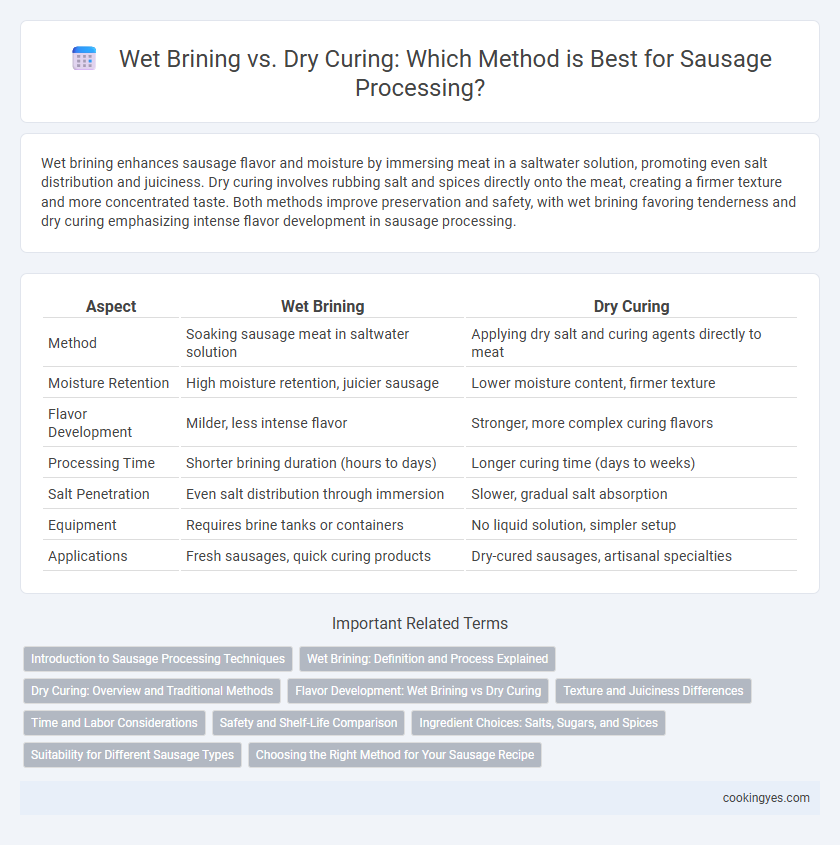Wet brining enhances sausage flavor and moisture by immersing meat in a saltwater solution, promoting even salt distribution and juiciness. Dry curing involves rubbing salt and spices directly onto the meat, creating a firmer texture and more concentrated taste. Both methods improve preservation and safety, with wet brining favoring tenderness and dry curing emphasizing intense flavor development in sausage processing.
Table of Comparison
| Aspect | Wet Brining | Dry Curing |
|---|---|---|
| Method | Soaking sausage meat in saltwater solution | Applying dry salt and curing agents directly to meat |
| Moisture Retention | High moisture retention, juicier sausage | Lower moisture content, firmer texture |
| Flavor Development | Milder, less intense flavor | Stronger, more complex curing flavors |
| Processing Time | Shorter brining duration (hours to days) | Longer curing time (days to weeks) |
| Salt Penetration | Even salt distribution through immersion | Slower, gradual salt absorption |
| Equipment | Requires brine tanks or containers | No liquid solution, simpler setup |
| Applications | Fresh sausages, quick curing products | Dry-cured sausages, artisanal specialties |
Introduction to Sausage Processing Techniques
Wet brining involves soaking sausage meat in a saltwater solution, enhancing moisture retention and flavor uniformity, while dry curing uses a precise layer of salt and curing agents to extract moisture, concentrating flavors and extending shelf life. The choice between wet brining and dry curing affects texture, taste, and preservation, with wet brining offering a juicier product and dry curing providing a firmer, more intensely flavored sausage. Understanding these sausage processing techniques is essential for achieving desired quality and safety standards in artisanal and commercial sausage production.
Wet Brining: Definition and Process Explained
Wet brining for sausage processing involves soaking the meat in a saltwater solution, which enhances moisture retention and improves texture and flavor profile. This method allows for even distribution of salt and curing agents, reducing the risk of dry spots and ensuring a consistent, juicy sausage product. The controlled soaking time and temperature are critical factors to optimize protein binding and microbial safety during wet brine curing.
Dry Curing: Overview and Traditional Methods
Dry curing in sausage processing involves applying salt and curing agents directly to the meat, drawing out moisture to prevent bacterial growth while enhancing flavor and texture. Traditional methods rely on a careful balance of salt, nitrates or nitrites, and controlled environmental conditions such as temperature and humidity for several weeks or months. This technique creates firm, intensely flavored sausages like salami and pepperoni, known for their rich aroma and long shelf life without refrigeration.
Flavor Development: Wet Brining vs Dry Curing
Wet brining infuses sausages with moisture and salt, enhancing juiciness and subtle savory flavors through diffusion during fermentation. Dry curing concentrates flavors by drawing out moisture, intensifying umami and creating complex, tangy profiles via enzymatic reactions over extended aging. Both methods influence sausage flavor development distinctly, with wet brining promoting tender, mildly salty tastes and dry curing producing robust, deeply savory notes.
Texture and Juiciness Differences
Wet brining infuses sausage meat with moisture through a saltwater solution, resulting in a tender, juicy texture by enhancing water retention during cooking. Dry curing relies on salt and spices drawing out moisture, creating a denser texture and intensifying flavor while reducing juiciness. Texture in wet-brined sausages tends to be softer and more succulent, whereas dry-cured sausages exhibit a firmer, chewier bite with concentrated taste.
Time and Labor Considerations
Wet brining sausages typically requires less initial labor due to its straightforward soaking process but demands extended time for thorough moisture absorption, often ranging from 12 to 48 hours. Dry curing involves more intensive labor in applying precise salt and seasoning mixtures directly to the meat, with curing times extending from several days to weeks depending on sausage type and desired flavor development. Time efficiency favors wet brining in high-volume production, while dry curing offers artisanal quality at the cost of increased labor and longer processing periods.
Safety and Shelf-Life Comparison
Wet brining introduces moisture and salt into sausage, enhancing microbial control and extending shelf life by reducing pathogen growth. Dry curing involves salt and curing agents without added water, creating a low-moisture environment that inhibits bacterial proliferation, resulting in longer shelf stability. Both methods improve safety, but wet brining offers quicker dehydration and flavor infusion, while dry curing provides superior preservation over extended storage periods.
Ingredient Choices: Salts, Sugars, and Spices
Wet brining in sausage processing typically uses a balanced solution of salts, sugars, and water to enhance moisture retention and flavor infusion, while dry curing relies on a precise blend of salt, curing agents like sodium nitrite, and spices applied directly to the meat surface. Salt in wet brining regulates microbial growth and texture, sugars promote fermentation and browning, and spices such as black pepper, garlic, and paprika add characteristic taste profiles. Dry curing requires careful measurement of curing salts and spices to ensure preservation and development of complex flavors without the dilution effects present in wet brines.
Suitability for Different Sausage Types
Wet brining suits fresh sausages like bratwurst and Italian sausages by enhancing moisture retention and flavor infusion, providing a juicy texture. Dry curing is ideal for dry-cured sausages such as salami and pepperoni, promoting preservation and complex flavor development through controlled drying and fermentation. Selecting between wet brining and dry curing depends on the desired sausage type, texture, and shelf-life requirements.
Choosing the Right Method for Your Sausage Recipe
Wet brining infuses sausages with moisture and flavor by immersing the meat in a seasoned saltwater solution, ideal for recipes requiring juiciness and tenderness. Dry curing involves rubbing the meat with a mix of salt, sugar, and spices, drawing out moisture and enhancing preservation while developing intense, concentrated flavors. Selecting the right method depends on desired texture, flavor intensity, and processing time, with wet brining suited for fresh sausages and dry curing preferred for traditional, shelf-stable varieties.
Wet brining vs dry curing for sausage processing Infographic

 cookingyes.com
cookingyes.com